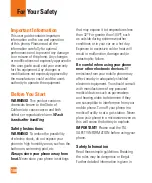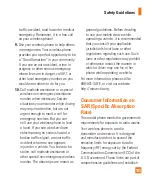
120
Safety Guidelines
headphones (including headsets, earbuds
and Bluetooth
®
or other wireless devices).
Exposure to very loud sound has also
been associated in some studies
with tinnitus (a ringing in the ear),
hypersensitivity to sound and distorted
hearing. Individual susceptibility to noise-
induced hearing loss and other potential
hearing problems varies.
The amount of sound produced by a
portable audio device varies depending
on the nature of the sound, the device,
the device settings and the headphones.
You should follow some commonsense
recommendations when using any
portable audio device:
204 Safety
Set the volume in a quiet environment
and select the lowest volume at which
you can hear adequately.
When using headphones, turn the
volume down if you cannot hear the
people speaking near you or if the
person sitting next to you can hear
what you are listening to.
Do not turn the volume up to block
out noisy surroundings. If you choose
to listen to your portable device in a
noisy environment, use noisecancelling
headphones to block out background
environmental noise.
Limit the amount of time you listen.
As the volume increases, less time is
required before your hearing could be
affected.
Avoid using headphones after exposure
to extremely loud noises, such as rock
concerts, that might cause temporary
hearing loss. Temporary hearing loss
might cause unsafe volumes to sound
normal.
Do not listen at any volume that causes
you discomfort. If you experience
ringing in your ears, hear muffled
speech or experience any temporary
hearing difficulty after listening to your
portable audio device, discontinue use
and consult your doctor.
You can obtain additional information on
this subject from the following sources:
Safety 205
American Academy of Audiology 11730
Plaza American Drive, Suite 300
Reston, VA 20190
Voice: (800) 222-2336
















































